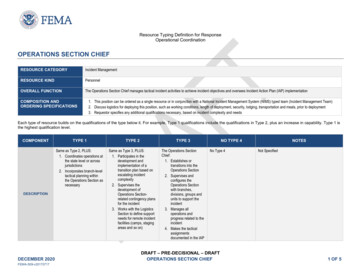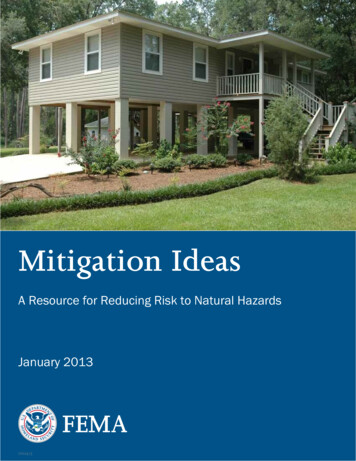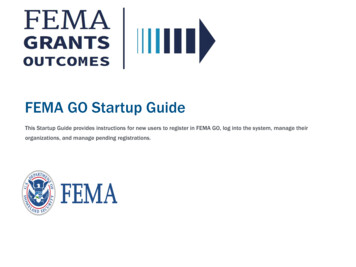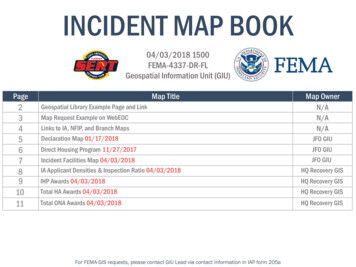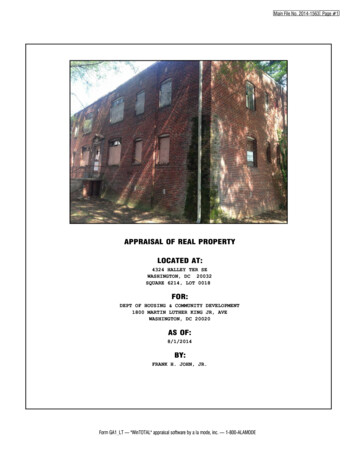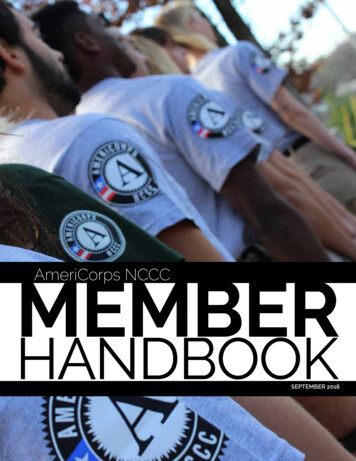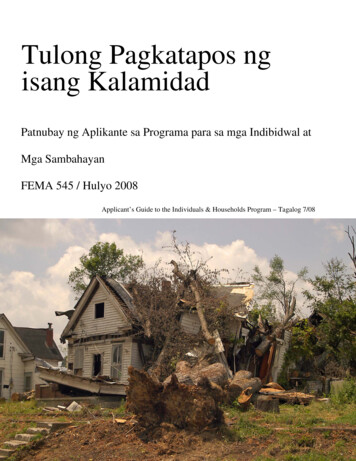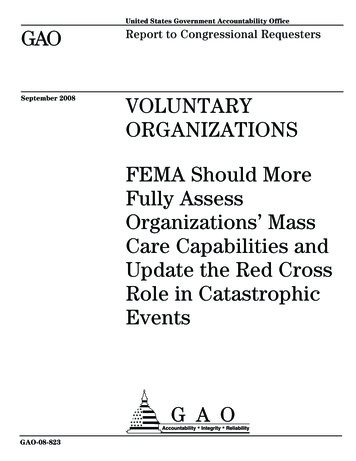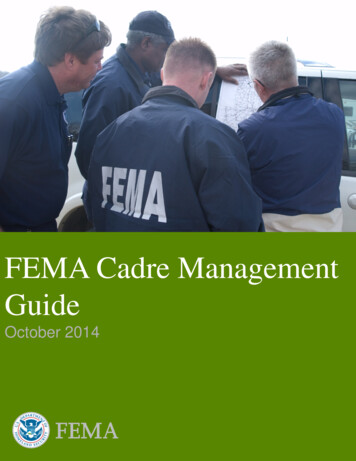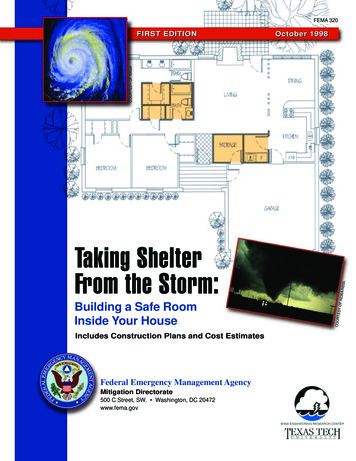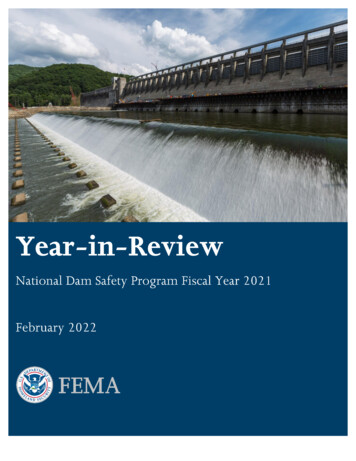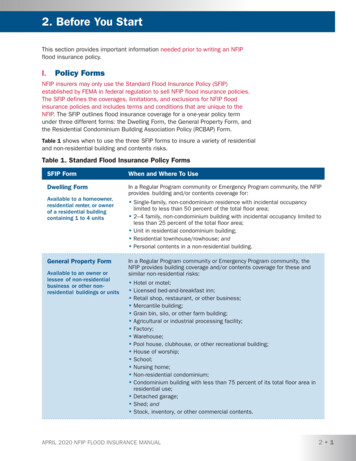
Transcription
2. Before You StartThis section provides important information needed prior to writing an NFIPflood insurance policy.I.Policy FormsNFIP insurers may only use the Standard Flood Insurance Policy (SFIP)established by FEMA in federal regulation to sell NFIP flood insurance policies.The SFIP defines the coverages, limitations, and exclusions for NFIP floodinsurance policies and includes terms and conditions that are unique to theNFIP. The SFIP outlines flood insurance coverage for a one-year policy termunder three different forms: the Dwelling Form, the General Property Form, andthe Residential Condominium Building Association Policy (RCBAP) Form.Table 1 shows when to use the three SFIP forms to insure a variety of residentialand non-residential building and contents risks.Table 1. Standard Flood Insurance Policy FormsSFIP FormWhen and Where To UseDwelling FormIn a Regular Program community or Emergency Program community, the NFIPprovides building and/or contents coverage for:Available to a homeowner,residential renter, or ownerof a residential buildingcontaining 1 to 4 units Single-family, non-condominium residence with incidental occupancylimited to less than 50 percent of the total floor area; 2–4 family, non-condominium building with incidental occupancy limited toless than 25 percent of the total floor area; Unit in residential condominium building; Residential townhouse/rowhouse; and Personal contents in a non-residential building.General Property FormAvailable to an owner orlessee of non-residentialbusiness or other nonresidential buildings or unitsIn a Regular Program community or Emergency Program community, theNFIP provides building coverage and/or contents coverage for these andsimilar non-residential risks: Hotel or motel; Licensed bed-and-breakfast inn; Retail shop, restaurant, or other business; Mercantile building; Grain bin, silo, or other farm building; Agricultural or industrial processing facility; Factory; Warehouse; Pool house, clubhouse, or other recreational building; House of worship; School; Nursing home; Non-residential condominium; Condominium building with less than 75 percent of its total floor area inresidential use; Detached garage; Shed; and Stock, inventory, or other commercial contents.APRIL 2020 NFIP FLOOD INSURANCE MANUAL2 1
2. Before You StartTable 1. Standard Flood Insurance Policy Forms continuedSFIP FormWhen and Where To UseGeneral Property FormIn a Regular Program community or Emergency Program community, theNFIP provides building and/or contents coverage for these residential riskswith 5 or more units: Apartment buildings; Residential cooperative buildings; Dormitories; Assisted-living facilities; and Hotels, motels, tourist homes, and rooming houses that have 5 or moreunits where the normal guest occupancy/stay is 6 months or more.Available to an owner ofresidential building with 5 ormore unitsRCBAPIssued to a residentialcondominium associationon behalf of association andunit ownersIn a Regular Program community only, the NFIP provides building coverageand, if desired, coverage of commonly owned contents for a residentialcondominium building with 75 percent or more of its total foor area inresidential use.II. Eligibility of Property Locations, Buildings,and ContentsAn individual property’s eligibility for an NFIP flood insurance policydepends on:1. The location of the building;2. Having an insurable building; and3. Having insurable contents.A. Eligibility of Property Locations1. Where the NFIP Offers InsuranceThe NFIP offers insurance for buildings and contents located withinparticipating NFIP communities or located on federal land.Table 2 explains what an NFIP participating community is and provides alist of the stages of a participating community.Table 2. Where the NFIP Offers InsuranceLocationDescriptionNFIP ParticipatingCommunitiesThe NFIP insures buildings and contents located within participating NFIPcommunities or located on federal land.A community must adopt a foodplain management ordinance that meets orexceeds the minimum NFIP criteria and have a Flood Insurance Rate Map (FIRM)or a Flood Hazard Boundary Map (FHBM) for the community to participate inthe NFIP. Check with the insurer to determine the community status or refer tothe Community Status Book at am-community-status-book.APRIL 2020 NFIP FLOOD INSURANCE MANUAL2 2
2. Before You StartTable 2. Where the NFIP Offers Insurance continuedLocationEmergencyProgramDescriptionThe Emergency Program represents the initial phase of a community’sparticipation in the NFIP in which limited amounts of coverage are available.Note: Participating communities in the Emergency Program remain in theEmergency Program if an FHBM is rescinded.Regular ProgramThe Regular Program is the fnal phase of a community’s participation in theNFIP. In this phase, the completed FIRM is in effect and full coverage limitsare available.NFIP Participating FEMA may place a participating NFIP community on probation when it does notCommunities oncomply with the NFIP’s foodplain management requirements. Probation endsProbationwhen the community remedies all defciencies. Insurance is available while thecommunity is on probation.FEMA applies a 50 Probation Surcharge to all policies in the community,issued on or after the probation effective date. The NFIP exempts the GroupFlood Insurance Policy (GFIP) from the surcharge. FEMA may suspend thecommunity if it does not remedy the violations during the probationary period.Federal LandNFIP food insurance is available on land owned by the Federal Governmentwhen the local community meets the foodplain management requirements. TheNFIP records all federal land under a local community number even if that localcommunity does not have jurisdiction.2. Where the NFIP Does Not Offer InsuranceTable 3 shows the locations where the NFIP does not offer insurance.Table 3. Where the NFIP Does Not Offer nitiesThe NFIP may not sell or renew food insurance in a community that does notparticipate in the NFIP. Once FEMA provides a community with an FHBM ora FIRM delineating its food-prone areas, the community has one year fromthat date to qualify as an NFIP participating community before this prohibitionbecomes effective. Check with the insurer to determine the community statusor refer to the Community Status Book at am-community-status-book.Suspended NFIPCommunityThe NFIP may not sell or renew food insurance in a community suspended fromthe NFIP. Current policies in the suspended community remain in effect untilpolicy expiration. The NFIP may not renew a policy while the community is suspended. Insurers must cancel any policies issued in error or any policy renewed afterthe date of a community suspension. To obtain coverage after the NFIP reinstates a community, property ownersshould contact their agent or insurer to submit a new application. Insurers must use the applicable waiting period required to obtain coverage.APRIL 2020 NFIP FLOOD INSURANCE MANUAL2 3
2. Before You StartTable 3. Where the NFIP Does Not Offer Insurance continuedLocationDescriptionAreas Covered bythe Coastal BarrierResources ActFlood insurance may not be available in System Units or Otherwise ProtectedAreas (OPAs) identified under the Coastal Barrier Resources System (CBRS).Such areas designated under the CBRS are typically undeveloped coastalbarriers within the boundaries of areas established under federal, state, or locallaw, or held by a qualified organization, primarily for wildlife refuge, sanctuary,recreational, or natural resource conservation purposes. Refer to the CBRSappendix of this manual for additional information.B. Building EligibilityThe NFIP will insure a building affixed to a permanent site that: Has two or more outside rigid walls with a fully secured roof; Resists flotation, collapse, and lateral movement; and Has at least 51 percent of the Actual Cash Value (ACV) of the building,including machinery and equipment that are a part of the building,above ground level unless the lowest level of the affixed structure isat or above the Base Flood Elevation (BFE) and is below groundusing earth as insulation material in conjunction with energy-efficientbuilding techniques.1. Eligible Types of BuildingsTable 4 describes the types of buildings the NFIP insures.Table 4. Buildings the NFIP InsuresBuilding TypeDescriptionDetached GarageIn general, the SFIP can only cover one building. However, the Dwelling Formincludes limited coverage for a detached garage servicing a 1–4 family dwelling.Coverage is limited to no more than 10 percent of the limit of liability on the 1–4family dwelling. This coverage does not apply to garages used for residential,business, or farming purposes.ManufacturedHome/Travel TrailerWithout WheelsA manufactured home (also known as a mobile home) is a structure built on apermanent chassis, transported to a site in one or more sections, and affxed to apermanent foundation.A travel trailer without wheels, built on a chassis and affxed to a permanentfoundation, is eligible for food coverage where regulated under the community’sfoodplain management and building ordinances or laws.Manufactured (mobile) homes and travel trailers must meet the followingrequirements to be eligible for NFIP coverage: Be affixed to a permanent foundation that may be a poured masonry slab,foundation walls, piers, or blocks so that the wheels and axles of the mobile homedo not support its weight; and Be anchored to a permanent foundation to resist flotation, collapse, or lateralmovement by providing over-the-top or frame ties to ground anchors; or inaccordance with manufacturer’s specifications; or in compliance with thecommunity’s floodplain management requirements.APRIL 2020 NFIP FLOOD INSURANCE MANUAL2 4
2. Before You StartTable 4. Buildings the NFIP Insures continuedBuilding TypeDescriptionManufacturedHome/Travel TrailerWithout Wheels,continuedManufactured (mobile) homes continuously insured since September 30, 1982,can renew under the previously existing requirements if they meet the followingconditions: Are affixed to a permanent foundation in compliance with the foundation andanchoring requirements at the time of placement. To be adequately anchored, the foundation support system must secure themanufactured or mobile home into the ground sufficiently to resist flotation,collapse, and lateral movement caused by flood forces, including wind forces incoastal areas.Note: All references in this manual to manufactured (mobile) homes are specifc tomanufactured (mobile) homes and travel trailers without wheels when affxed to apermanent foundation.CondominiumBuildingA condominium is a building or a complex of buildings containing a numberof individually owned apartments or houses where each unit owner has an undividedinterest in common elements of the building. Residential condominium buildingsmust be insured under the RCBAP.Cooperative Building Corporations own and manage cooperative buildings, and their ownership differsfrom the condominium form of ownership. Residents within cooperative buildingsbuy shares of the corporation, rather than the real estate (building, land, or bothbuilding and land). To qualify as a residential occupancy, a cooperative buildingmust have at least 75 percent of the total foor area used for residential purposes.Cooperative buildings are not eligible for the RCBAP.Homeowners’Association (NonCondominium)A Homeowners’ Association not in the condominium form of ownership owns thecommon areas and individual building owners have a right to use and enjoy thecommon areas. A Homeowners’ Association can purchase a policy for an individualbuilding in the building owner’s name when the Association’s by-laws require theAssociation to purchase food insurance building coverage for its members. AHomeowners’ Association not in the condominium form of ownership is not eligiblefor the RCBAP.Timeshare BuildingA timeshare is an arrangement where several joint owners have the right to usea property under a time-sharing agreement and where the corporation ownsthe building. The NFIP insures individual units in a timeshare building in thecondominium form of ownership under the Dwelling Form. These buildings areeligible for coverage under the RCBAP if 75 percent of the total floor area of thebuilding is for residential purposes. If the 75% criteria is not met, refer to IV.Condominiums in the How To Write section.Building PartiallyUndergroundThe NFIP insures buildings or units and eligible contents if 49 percent or less ofthe ACV, including machinery, is below ground when an energy effcient buildingtechnique uses earth as an insulator. The lowest foor must be at or above the BFE.AgriculturalStructureA structure used exclusively in connection with the production, harvesting, storage,raising, or drying of agricultural commodities. Examples of eligible agriculturalstructures include barns, silos, and grain storage buildings.Building EntirelyOver Water beforeOctober 1, 1982The NFIP will insure a building located entirely in, on, or over water, or seaward ofmean high tide, that was not constructed or substantially improved after September30, 1982. Refer to the How to Write section of this manual for rating information.APRIL 2020 NFIP FLOOD INSURANCE MANUAL2 5
2. Before You StartTable 4. Buildings the NFIP Insures continuedBuilding TypeDescriptionBuilding PartiallyOver WaterThe NFIP may insure a building not “entirely” over water, i.e., when part of theexterior perimeter walls and foundation of the building are on land or on thelandward side of mean high tide (mean high water). Refer to the How to Writesection of this manual for rating information.Note: When the exterior perimeter walls of the building are completely over water,but the support system or foundation underneath the building extends onto land,or the extension of any mechanism for access into the building (including, but notlimited to, stairs, decks, walkways, piers, posts, pilings, docks, or driveways) is fullyor partially on land, the building and the access are ineligible for coverage.Building BecomesEntirely Over WaterA building originally constructed on land or partially over water that later becomesentirely over water because of erosion is eligible for coverage if the building hashad continuous coverage. Coverage must have been in place for at least one yearprior to the building being located entirely over water (regardless of any changes inthe ownership of the building) or from the date of construction if less than one year.Refer to the How to Write section of this manual for rating information.Boathouse LocatedPartially Over WaterThe NFIP insures the non-boathouse parts of a building into which boats are foated,if the building is partly over land and also used for residential, commercial, ormunicipal purposes and is eligible for food coverage. The NFIP does not insure boatrepair docks or boat storage over water.The NFIP will insure the area above the boathouse used for purposes unrelatedto the boathouse use (e.g., residential use) from the foor joists to the roof,including walls, and a common wall between the boathouse area and other parts ofthe building.The following items are not covered (refer to the SFIP for the limitations on coverage): The ceiling and roof over the boathouse portions of the building into which boatsare floated; Floors, walkways, decking, etc., within the boathouse area, or outside the area,but pertaining to boathouse use; Exterior walls and doors of the boathouse area not common to the rest ofthe building; Interior walls and coverings within the boathouse area; and Contents located within the boathouse area, including furnishings and equipment,relating to the operation and storage of boats and other boathouse uses.Building inthe Course ofConstructionThe NFIP will insure a building in the course of construction before it is walled androofed using the NFIP-issued rates based on the construction designs and theintended use of the building.Buildings in the course of construction that are not walled and roofed are noteligible for coverage when construction stops for more than 90 days and/or ifthe lowest foor for rating purposes is below the BFE. The NFIP will not insurematerials or supplies intended for use in such construction, alteration, or repairunless they are contained within an enclosed building on the premisesor adjacent to the premises.Important: If a building under construction, alteration, or repair does not have atleast two rigid exterior walls and a fully secured roof at the time of loss, then thedeductible amount will be two times the deductible that would otherwise apply toa completed building. See SFIP Sec. VI.A.APRIL 2020 NFIP FLOOD INSURANCE MANUAL2 6
2. Before You StartTable 4. Buildings the NFIP Insures continuedBuilding TypeDescriptionAdditions andExtensionsWhen insuring a building with multiple additions, the applicant must choosebetween purchasing one policy or separate policies for the building and eachaddition and extension.Additions and extensions attached to and in contact with the building by thefollowing methods may be insured under a separate policy: Rigid exterior wall Solid load-bearing interior wall Stairway Elevated walkway RoofThe NFIP requires an application for each addition and extension insuredseparately.The application must: Clearly describe the separately insured addition and extension; Contain the rating information specific to the addition and extension; and Request building and/or contents coverage for the addition and extension.The application for the main building should reference the policy number or quotenumber for the policy covering the addition or extension separately.Note: Additions and extensions cannot be excluded from building coverage underthe main building’s policy unless the additions and extensions are insured separately.2. Ineligible Types of BuildingsNFIP does not insure the buildings shown in Table 5.Table 5. Buildings the NFIP Does Not InsureBuilding TypeDescriptionBuilding Declaredin Violationof FloodplainManagementRequirementsThe NFIP may not insure buildings (or their contents) declared to be constructedor altered in violation of state or local foodplain management laws, regulations,or ordinances. Section 1316 of the National Flood Insurance Act of 1968 (NFIA)allows state or local governments to make this declaration. Insurance becomesavailable when the owner corrects the violation and the state or local governmentrescinds the Section 1316 declaration.Container-TypeBuildingThe NFIP does not insure containers used to store gas and liquids, chemical or reactorcontainer tanks or enclosures, brick kilns, and similar units, and their contents.Building EntirelyOver Water On orAfter October 1,1982The NFIP does not insure buildings constructed or substantially improved on or afterOctober 1, 1982, located entirely in, on, or over water, or seaward of mean high tide.Water TreatmentPlantThe NFIP does not insure a water treatment plant unless 51% or more of its ACV isabove ground.APRIL 2020 NFIP FLOOD INSURANCE MANUAL2 7
2. Before You StartTable 5. Buildings the NFIP Does Not Insure continuedBuilding TypeDescriptionBuilding Used forthe Manufactureor Distribution ofa ControlledSubstanceThe NFIP may not knowingly insure a building or its contents used for themanufacture or distribution of a controlled substance in violation of federal law.Doing so would directly promote, effectuate, or encourage a violation of the law,which would violate public policy and general principles of insurance. This restrictionincludes buildings or contents used to grow or dispense marijuana in locationswhere this activity is legal under state law because governing federal law makes itunlawful to use any place for the manufacture or distribution of a controlledsubstance. FEMA can provide additional information on the application of thisguidance to specific circumstances.C. Contents EligibilityThe NFIP only insures contents located in a building that is eligible forbuilding coverage. Dwelling Form: Contents must be located inside a building at thedescribed location. If the building is not fully enclosed, contents mustbe secured to prevent flotation out of the building. General Property Form: Contents must be located inside the fullyenclosed insured building. RCBAP Form: Contents must be located inside the fully enclosedinsured building.1. Eligible ContentsExamples of eligible contents include: Personal property inside a building at the described location, if:– The property is owned by the insured or the insured’s householdfamily members; or– At the insured’s option, the property is owned by guests or servants; Equipment; Self-propelled vehicles or machines, not licensed for use on publicroads, and– Used mainly to service the described location; or– Designed and used to assist handicapped persons while the vehiclesor machines are inside a building at the described location; Parts and equipment as open stock, not part of a specific vehicle ormotorized equipment; Contents located in silos, grain storage buildings, and cisterns; Commercial contents; Contents in units in a cooperative building:– Residents of a unit within a cooperative building may purchasecontents coverage under the Dwelling Form;– Shareholders may apply 10 percent of the contents coverage forbetterments and improvements at the time of loss; Contents in a non-residential condominium unit; and Personal property removed to safety at another location to protect itfrom flood or the imminent danger of flood, for a period of 45 days.APRIL 2020 NFIP FLOOD INSURANCE MANUAL2 8
2. Before You Start2. Ineligible ContentsExamples of ineligible contents under certain NFIP policy forms include: Automobiles including assembled and unassembled dealer’s stock; Motorcycles including assembled and unassembled dealer’s stock; Motorized Equipment including assembled and unassembled dealer’sstock; and Bailee customer’s goods including contractors, cleaners, repair shops,processors of goods belonging to others, and similar risks.D. NFIP Coverage Exclusions and LimitationsTable 6 shows examples of NFIP coverage exclusions and limitations.Table 6. NFIP Coverage Exclusions and LimitationsTypes of Exclusionand LimitationsCommentBasementThe SFIP limits coverage for basement improvements, such as fnishedwalls, foors, ceilings, or personal belongings kept in a basement.Elevated Building withEnclosureThe SFIP limits coverage for enclosed, walled-in areas below the lowestfoor of a Post-FIRM elevated building located in an SFHA, including fnishedwalls, foors, ceilings, or personal belongings kept in an enclosure.Swimming PoolThe SFIP excludes coverage for indoor or outdoor swimming pools.DeckThe SFIP limits coverage for decks except for steps and landings to amaximum landing area of 16 square feet.Hot Tub or SpaThe SFIP excludes coverage for hot tubs or spas except where used asbathroom fxtures.Building Coverage for a Unitin a Cooperative BuildingThe NFIP does not provide building coverage for shareholder units in acooperative building.Residents or tenants of a cooperative building may purchase contentscoverage under the Dwelling Form.Non-ResidentialCondominium UnitThe NFIP does not provide building coverage for owners of non-residentialunits in residential or non-residential buildings.Timeshare Unit in a MultiUnit BuildingThe NFIP does not provide coverage for these units unless they are in acondominium form of ownership.Flood in ProgressThe SFIP excludes coverage of losses caused directly or indirectly by a foodthat is already in progress at the time and date:1. The policy's first term begins; or2. Coverage is added at the policyholder’s request.Therefore, damage from a food that begins before the policy’s frst termbegins is not covered even if the flood does not damage the insuredproperty until after the policy term begins. When coverage is added to anexisting policy at the request of the policyholder and a flood is already inprogress, damage that occurs to insured property from that same floodevent after the effective date of the increased coverage will only be coveredunder the lesser policy limits.APRIL 2020 NFIP FLOOD INSURANCE MANUAL2 9
2. Before You StartIII. Coverage D – Increased Cost of Compliance (ICC)CoverageThe SFIP includes ICC coverage that pays up to 30,000, subject to eligibility,towards the cost to repair or rebuild a flood-damaged structure in compliancewith state or local floodplain management ordinances or laws. ICC coverage isnot available for: Emergency Program policies; Contents-only policies; Dwelling Form policies on individual condominium units includingtownhouse/rowhouse condominiums (The condominium association isresponsible for complying with mitigation requirements.); GFIPs; or Detached garages, unless covered by a separate policy.The ICC premium is not eligible for the deductible discount.ICC coverage is in addition to the amount of building coverage purchased andthe total cannot exceed the maximum program limits.Compliance activities eligible for payment are elevation, floodproofing,relocation, demolition, or any combination of these activities. Eligiblefloodproofing activities apply only to non-residential structures andresidential structures with basements that satisfy FEMA’s standardspublished at 44 CFR 60.6.IV. Insurance ProductsTable 7 shows the NFIP insurance products that are currently available.Table 7. NFIP Insurance Products AvailablePolicy TypeDescriptionPreferred Risk Policy(PRP)The PRP is a lower cost policy available for properties located in B, C, X, AR,or A99 zones on the current FIRM that have limited loss history. See theHow To Write section for more information.Newly Mapped RatingProcedureThe Newly Mapped rating procedure applies to properties previouslylocated in Zones B, C, X, D, AR, or A99 and newly mapped into aSpecial Flood Hazard Area (SFHA) on the current map.Mortgage PortfolioProtection Program(MPPP) PolicyThe MPPP is a force-placed policy available only through a Write Your Own(WYO) Company. See the MPPP section of this manual for more information.Scheduled Building PolicyThe Scheduled Building Policy provides a group of policies for buildings thathave the same ownership and the same location; the properties where thebuildings are located must be contiguous. The policy is available to cover 2to 10 buildings and requires the insured to designate a specifc amount ofinsurance for each building.NFIP requires a separate application for each building and/or contentspolicy; The Federal Policy Fee is 50 per building; and The HFIAA Surcharge is charged for each building.APRIL 2020 NFIP FLOOD INSURANCE MANUAL2 10
2. Before You StartTable 7. NFIP Insurance Products Available continuedPolicy TypeDescriptionGroup Flood InsurancePolicy (GFIP)A GFIP is a policy covering all individuals named by a State as recipientsunder section 408 of the Robert T. Stafford Disaster Relief and EmergencyAssistance Act1 of an Individuals and Households Program award forfood damage as a result of a major disaster declaration by the President.The amount of coverage is equivalent to the maximum grant amountestablished under section 408. The term of the GFIP is for 36 monthsand begins 60 days after the date of the disaster declaration. Coveragefor individual grantees begins on the thirtieth day after the NFIP receivesthe required data for individual grantees and their premium payments. Aninsured may cancel a GFIP at any time and secure a regular SFIP throughthe NFIP.1. Pub. L. No. 93-288, 88 Stat. 143; 42 U.S.C. 5174V. Effective Dates for New PoliciesA. Waiting PeriodsIn general, new policies for flood insurance become effective following a 30-daywaiting period. However, there are three exceptions listed below and detailedlater in this section:1. Map Revision Exception (Sec. VI.A.2): Coverage becomes effective aftera one-day waiting period during the first 13 months following the revisionof a flood map in the property’s community.2. Mortgage Loan Exception (Sec. VI.A.3): Coverage becomes effective atthe time of the closing when the initial purchase of flood insurance is inconnection with a mortgage loan transaction.3. Post-Wildfire Exception (Sec. VI.B): Coverage becomes effectiveimmediately if:a. The covered property experiences damage caused by flood thatoriginated on federal land;b. Post-wildfire conditions on federal lands caused or worsened theflooding; andc. The insured purchased the policy either:i. Before the fire containment date; orii. During the 60-calendar day period following the firecontainment date.Insurers must follow the applicable waiting period and effective date rulesfor all policies, including submit-for-rate submissions and policies issuedin conjunction with a community’s initial entry into the Regular Program orconversion from the Emergency Program to the Regular Program.Contents-only policies are subject to a 30-day waiting period unless thecontents are part of the security for a loan.1. Standard 30-day Waiting PeriodA 30-day waiting period applies to new policies not otherwise eligible for theexceptions provided above. The date the waiting period begins varies based on: The date the insurer receives the application and payment; The date of the application; and The method of sending the application and payment.APRIL 2020 NFIP FLOOD INSURANCE MANUAL2 11
2. Before You StartFor the purposes of determining a waiting period start date, “certified mail”includes certified mail sent through the U.S. Postal Service or reputable thirdparty delivery services that provides proof of the actual mailing date and deliverydate to the insurer.Table 8 shows how to determine the effective date of a new policy with a
Federal Land NFIP food insurance is available on land owned by the Federal Government when the local community meets the foodplain management requirements. The NFIP records all federal land under a local community number even if that local community does not have jurisdiction. 2.Where the NFIP Does Not Offer Insurance
